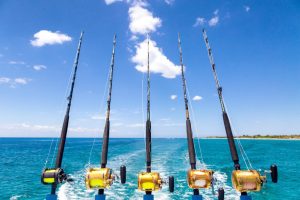Deep sea fishing requires robust gear to handle the powerful fish lurking in the depths, and nothing is more important than a properly spooled fishing line. Incorrectly loaded line can result in tangles, breakages, and lost catches. With the fall season often marking the tail-end of popular deep sea fishing opportunities, now is the perfect time to ensure your equipment is in top shape for that final trip offshore. Here’s a step-by-step guide to properly putting line on your deep sea fishing rod.
Choose the Right Line for the Job
Before spooling your reel, it’s essential to select the appropriate type of fishing line. Most deep sea fishing setups use braided line for its strength-to-diameter ratio, allowing more line to be loaded onto the reel without sacrificing breaking strength. Braided lines are particularly useful when targeting large species like tuna, marlin, or swordfish, common targets in fall offshore fishing. Monofilament can also be used as a backing or for top shots to provide some stretch during the fight. Consider the species you’re after and the depth at which you’ll be fishing when choosing line weight and type.
Secure the Line to the Spool
Start by threading the line through the rod guides, beginning with the tip. Open the bail arm on your spinning reel or disengage the drag system on a conventional reel. Tie an arbor knot to secure the line to the spool, ensuring the knot is snug and won’t slip under pressure. This first step is crucial, as a loose knot can cause the line to slip when fighting a large fish, leading to a costly breakoff.
Maintain Proper Tension While Spooling
One of the most common mistakes when putting line on a deep sea reel is failing to maintain proper tension. Hold the line with a moderate amount of tension as you spool it onto the reel to avoid loose coils, which can cause backlashes or knots during casting. Some anglers find it helpful to have a friend assist by holding the line spool with a pencil inserted through the center to allow the line to wind smoothly onto the reel.

Spool the Line Evenly
Ensure that the line is loaded evenly across the entire width of the spool. An unevenly loaded reel can result in poor casting performance or line bunching, making it difficult to fight large fish effectively. Use your fingers to guide the line back and forth across the spool as you reel in. For deep sea fishing, it’s important to fill the spool to about 1/8 inch below the spool’s lip, maximizing the amount of line available for long runs from powerful fish.
Top It Off with a Leader
For deep sea fishing, adding a leader to the end of your mainline is a crucial final step. Leaders are usually made of fluorocarbon or monofilament, providing added abrasion resistance and invisibility underwater. Attach the leader with a strong knot, such as a double uni knot, ensuring it can handle the strain of a large catch. In the fall, when many fish are feeding aggressively before colder months, a sturdy leader can make all the difference in securing a trophy fish.
Spooling line correctly on a deep sea fishing rod is essential for maximizing performance and preventing costly mistakes. By choosing the right line, maintaining proper tension, and adding a strong leader, anglers can ensure their gear is ready for the next big catch. This fall, as the deep sea fishing season winds down, take the time to properly prepare your rod for one last offshore adventure.
Image: wavedancercharters





